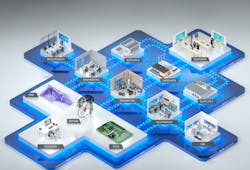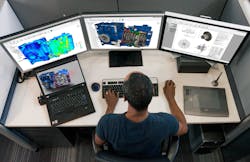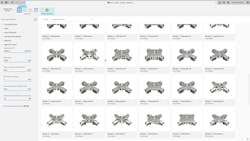The pace of change, competitive threats and supply chain volatility present challenges now, more than ever before.But there are growth opportunities all around us:
- The opportunity to address emerging trends like smart products
- Driving more efficiency and reducing costs
- Ensuring flexibility and agility in our supply chain
During the product development process today, a full 30 percent of an engineer’s time is wasted on tedious tasks like chasing down the right version of a file. It’s messy, complicated, and limits the ability to make changes quickly in order to survive. We need a new way. Imagine a single designer or engineer in an R&D department or small business. Engineers like this wear numerous hats. That has historically meant they’d use numerous design and engineering tools.
Fusion 360 is revolutionizing how engineering teams imagine, collaborate, and create, giving them the agility and connectivity to meet growing demands, the freedom to spend more time on innovating, rather than iterating, and the ability to improve their business and shape a thriving future.
Driving digital transformation
The global pandemic is accelerating digital transformation as a necessity, on top of the innovation it enables that was already proving its value. Designers and engineers need to collaborate more easily. They need to work together within their teams, across teams within a company, and across companies in their supply chain. Fusion 360 is a cloud-based platform that makes collaboration easy. Teams can access data from anywhere and collaborate on projects, which is obviously on increasingly value when half the business and supply chain is working remotely. GoWesty, an aftermarket VW supplier based in California, has a design and engineering team that develops hundreds of new products annually. Mechanical engineer Oren Klein at GoWesty comments that “It’s really handy to be able to work on dozens and dozens of projects independently on the cloud and not have to worry as much about file organization.”
Fusion 360 brings design and manufacturing closer together on a single integrated product development platform. We are eliminating the need for multiple solutions, for translation from one file format to another across the product development process and making it possible to go directly from design to making. Of course, Fusion 360 can also exchange data and work seamlessly with other tools and solutions across an organization or supply chain, when cross-platform compatibly is required.
Somni Solutions, a Fusion 360 user in the Netherlands, found nothing is faster than working on the cloud when the company needed to work fast in order to meet the accelerated timeline of the new Genova San Giorgio Bridge.
“One of the downsides of other modeling software is that integration onto the cloud is a very slow process, and professional licenses are extremely expensive. Fusion 360 is a whole different ballgame. The pricing is much more competitive, it’s much easier to add or get rid of an extra account, and you have the whole package, including cloud simulation, available at your command.”
Rik Knoppers, Chief Operating Officer, Somni Solutions
Intelligently power your decision-making
Smart decision making in today’s world of fast product development requires connecting design and manufacturing, which the cloud helps from a file management standpoint–but its value doesn’t end there. Generative design in Fusion 360—the ability to receive design suggestions from the computer and fast-forward to identifying solutions a designer will explore more deeply—is one example. By using artificial intelligence to leverage the power of cloud computing, generative design enables manufacturers to explore multiple designs in less time than they could deliver a single concept using traditional processes. This ultimately results in creating better final outcomes and products. The generative design process is completely different than the traditional process: A designer specifies the functional requirements of a product and the constraints of the manufacturing process at their disposal in order to then receive generatively designed suggestions from the power of cloud computing that have been pre-validated for functional performance, manufacturability, and manufacturing cost. This process greatly reduces the need to pass designs back and forth, yielding a much shorter time to market, reduced costs and a greater range of innovative solutions.
“Generative design really allows us to tackle complex problems that would take somebody a lot more time than they have to go through different analyses. It’s a mind multiplier, I like to call it, where a single designer or engineer can go through perhaps dozens or even hundreds of different design iterations–designs they may never have considered otherwise—in the time it would ordinary take to create and assess two or three more familiar designs. It enables us to see new possibilities.”
John Suh, Vice President, Hyundai Motor Group
Ultimately, generative design gives human experts the time to focus on assessing which design options best meet their requirements for all phases of product design and manufacturing, as well as aesthetics and creativity. You can get to more high-performing, cost-effective, and sustainable designs that you couldn’t have reached on your own—faster.
Solving your product development challenges
Fusion 360’s flexible and intuitive platform can be configured to your team’s size, use case, and workflow; you have access to the enterprise-grade features and services you need but only pay for what you use. With an integrated platform that connects an entire product development and manufacturing ecosystem with a central, cloud-based model, you break down the friction between people, activities, and machines so teams collaborate more seamlessly and spend more time on innovation than iteration. Fusion 360 invests in the future of product development and manufacturing, catalyzing innovation across disciplines and giving teams the tools to automate mundane tasks, the agility and connectivity to manage supply networks, and access to the latest manufacturing technologies to realize previously impossible outcomes.
To find out more about how Fusion 360 can help your team achieve the new possible, visit www.autodesk.com/fusion-360
Sponsored by:




